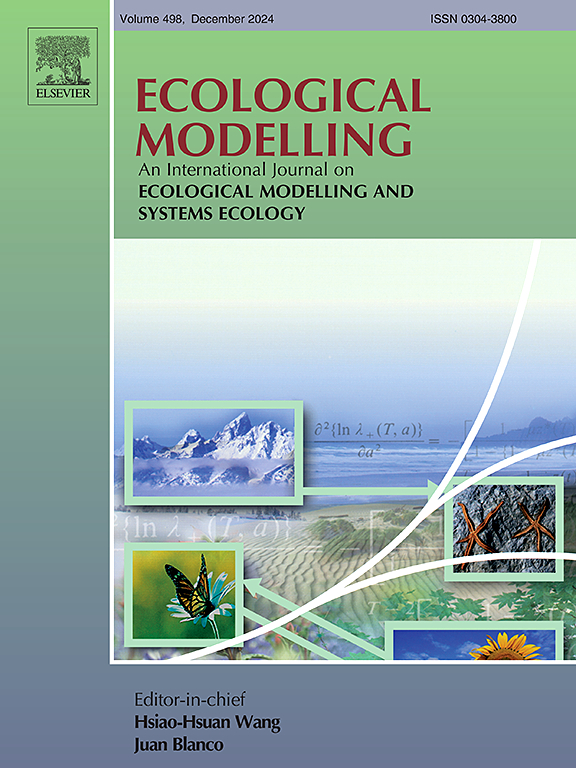Modeling polar bear (Ursus maritimus) snowdrift den habitat on Alaska's Beaufort Sea coast using SnowDens-3D and ArcticDEM data
IF 2.6
3区 环境科学与生态学
Q2 ECOLOGY
引用次数: 0
Abstract
Pregnant polar bears (Ursus maritimus) excavate maternal dens in seasonal snowdrifts during fall along Alaska's Beaufort Sea coast to shelter their altricial young during birth and development. With recent sea ice decreases, bears are denning more frequently on land. Each year, the weather and blowing-snow conditions control the creation of snowdrifts across the landscape. Therefore, available snowdrift den habitat can vary widely from one year to the next, depending on the late fall and early winter air temperature, snowfall, and wind speed and direction. We implemented a physics-based, spatiotemporal, polar bear snowdrift den habitat model (SnowDens-3D) across the eastern Alaska Beaufort Sea coast (an area of approximately 17,000 km2). High-resolution (2.0 m) topography data were provided by the ArcticDEM, and daily meteorological forcings were provided by NASA's MERRA-2 reanalysis. In many areas across the Arctic Alaska simulation domain, the raw ArcticDEM data contained physically unrealistic topographic anomalies (bumps and depressions) of similar magnitude (± 1.5 m) to the topographic variations that underlie potential den habitat (height differences of approximately 1.5 m). To create an ArcticDEM dataset for this den habitat model, considerable pre-processing of the ArcticDEM data was required; we implemented numerous filters to remove the topographic anomalies while preserving those topographic features capable of creating snowdrifts deep enough to provide viable polar bear den habitat. A 21-year (2000–2020) SnowDens-3D simulation was performed, and model outputs were compared with 91 historical polar bear den locations. The year-specific simulations identified viable den habitat for 98% of the observed den locations. The interannual variation in den habitat area over the 21-year period ranged by approximately a factor of three from the minimum year (2001; 554 km2) to the maximum year (2017; 1,566 km2). The ability to identify viable polar bear snowdrift den habitat in near-real time, as demonstrated here, will help wildlife managers and industry personnel identify potential polar bear maternity den sites and minimize disturbance to occupied dens.
利用SnowDens-3D和ArcticDEM数据对阿拉斯加波弗特海岸北极熊(Ursus maritimus)雪堆洞穴栖息地进行建模
怀孕的北极熊(Ursus maritimus)在阿拉斯加波弗特海岸的季节性雪堆中挖掘母熊的洞穴,在它们的晚育幼崽出生和发育期间为它们提供庇护。随着最近海冰的减少,熊更频繁地在陆地上筑巢。每年,天气和吹雪条件控制着整个景观中雪堆的形成。因此,可利用的雪堆洞穴栖息地每年都有很大的变化,这取决于晚秋和初冬的气温、降雪量、风速和风向。我们在阿拉斯加东部波弗特海岸(面积约17000平方公里)实施了一个基于物理的、时空的北极熊雪堆洞穴栖息地模型(snowden - 3d)。高分辨率(2.0 m)地形数据由ArcticDEM提供,日气象强迫数据由NASA MERRA-2再分析提供。在北极阿拉斯加模拟域的许多地区,原始ArcticDEM数据包含物理上不现实的地形异常(凹凸和洼地),其大小(±1.5 m)与潜在洞穴栖息地(高度差约1.5 m)的地形变化相似。为了创建该洞穴栖息地模型的ArcticDEM数据集,需要对ArcticDEM数据进行大量预处理;我们实施了许多过滤器来去除地形异常,同时保留那些能够产生足够深的雪堆的地形特征,为北极熊提供可行的洞穴栖息地。进行了21年(2000-2020)的SnowDens-3D模拟,并将模型输出与91个历史北极熊洞穴位置进行了比较。特定年份的模拟确定了98%观察到的洞穴位置的可行洞穴栖息地。在21年期间,洞穴栖息地面积的年际变化与最小年份(2001年;554 km2)至最大值年(2017年;1566平方公里)。在接近实时的情况下识别可行的北极熊雪堆洞穴栖息地的能力,将帮助野生动物管理人员和行业人员识别潜在的北极熊产卵洞穴地点,并最大限度地减少对已占用洞穴的干扰。
本文章由计算机程序翻译,如有差异,请以英文原文为准。
求助全文
约1分钟内获得全文
求助全文
来源期刊

Ecological Modelling
环境科学-生态学
CiteScore
5.60
自引率
6.50%
发文量
259
审稿时长
69 days
期刊介绍:
The journal is concerned with the use of mathematical models and systems analysis for the description of ecological processes and for the sustainable management of resources. Human activity and well-being are dependent on and integrated with the functioning of ecosystems and the services they provide. We aim to understand these basic ecosystem functions using mathematical and conceptual modelling, systems analysis, thermodynamics, computer simulations, and ecological theory. This leads to a preference for process-based models embedded in theory with explicit causative agents as opposed to strictly statistical or correlative descriptions. These modelling methods can be applied to a wide spectrum of issues ranging from basic ecology to human ecology to socio-ecological systems. The journal welcomes research articles, short communications, review articles, letters to the editor, book reviews, and other communications. The journal also supports the activities of the [International Society of Ecological Modelling (ISEM)](http://www.isemna.org/).
 求助内容:
求助内容: 应助结果提醒方式:
应助结果提醒方式:


